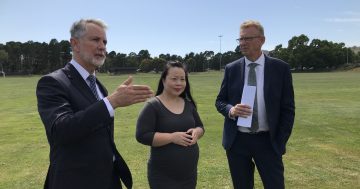
Former Labor chief minister Jon Stanhope is an unrelenting critic of the Barr Government. Photo: File.
There is a convention that former political leaders are supposed to stay out of the spotlight once they have left the arena but it seems these days that few rarely do.
Call it relevance deprivation syndrome, an ongoing commitment to public service or a media gig that needs regular feeding, the result can range from mere annoyance to fury, especially if the target used to be on the team you once played for.
For some time former Labor chief minister Jon Stanhope, assisted by former government economist Dr Khalid Ahmed at the University of Canberra, has been haunting Andrew Barr’s government via a regular spot in the weekly City News, pointing out the dire state of the Territory’s finances, the alleged underspending on health and housing, and the diversion of resources to light rail, or as it is more derisively known, ‘the tram’.
A recent column actually called on the government to stop the tram and start caring for the community, claiming the ACT did not have the finances to extend light rail.
When the government rolled out the still unused COVID-19 surge centre at Garran, Stanhope called it a panic-driven decision and the facility a $25 million shed.
If Barr had funded the hospital as he should have it would not have been necessary, he argued.
Stanhope and his number-crunching mate have consistently attacked the Territory’s financial position, not challenging the strong economy claim from Barr, but arguing spending is out of control and debt is blowing out unsustainably.

Stop the tram, says Stanhope, we need to get off.
There is no love lost between these two Labor figures. Stanhope often refers to the neo-liberal, pro-big business Barr Government and how it is betraying workers and the vulnerable in Canberra.
“The working poor, pensioners or people in lower-income households have been abandoned by the Labor Party, ignored by the unions and are invisible to the Greens. Ironically, they now have nowhere left to turn but to Alistair Coe – and who could blame them,” he wrote earlier in the year.
Barr’s approach has been to ignore Stanhope’s criticism and focus on flicking off the often ineffective arrows fired off without much thought by Alistair Coe’s Canberra Liberals, the official Opposition.
The problem is, Stanhope won’t go away, he has cred and a visible legacy every time Canberrans drive past the National Arboretum, which he championed. Along with a knack for a zinger, his theses are argued like an academic, based on actual research.
They often appear to have a more solid basis to them than anything the Liberals can throw at Barr.
As the ACT heads towards the October election, how long does Barr continue to turn a deaf ear to his former chief minister, or how long will he be allowed to do so?
When does Stanhope become a political problem that has to be confronted?
No doubt Barr’s old Labor mate will pour some more fuel on the fire during the campaign, and could be more of a threat to the Labor ascendancy in Canberra than the Liberals.
There’s nothing lower in Labor folklore than a rat who turns on the party that nurtured it.
But Stanhope has always been a man of principle, stiff and prickly maybe, but resolute in taking the higher ground and telling it like it is.
And with a regular audience in the shopping centre freebie, Andrew Barr might ignore the Stanhope factor at his peril.














